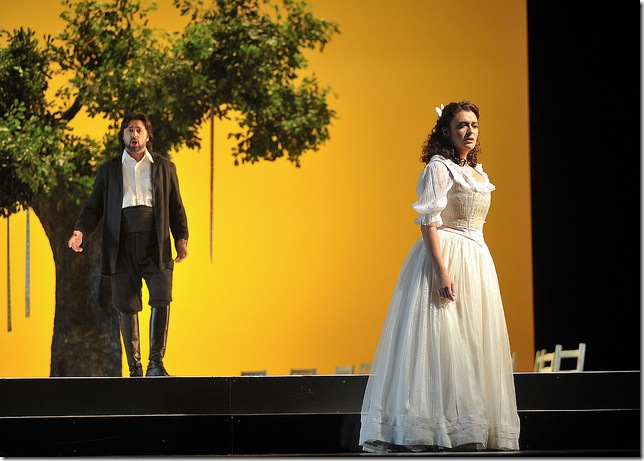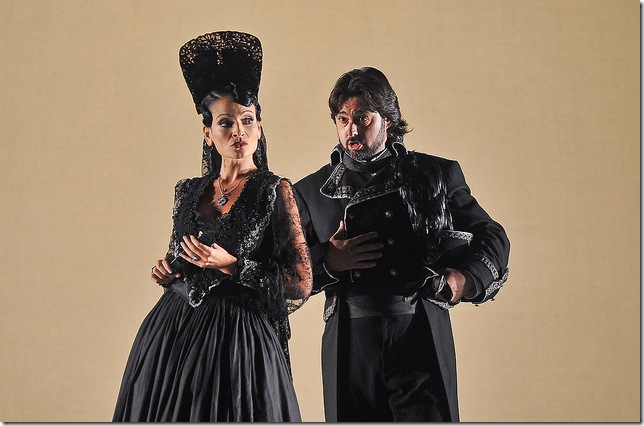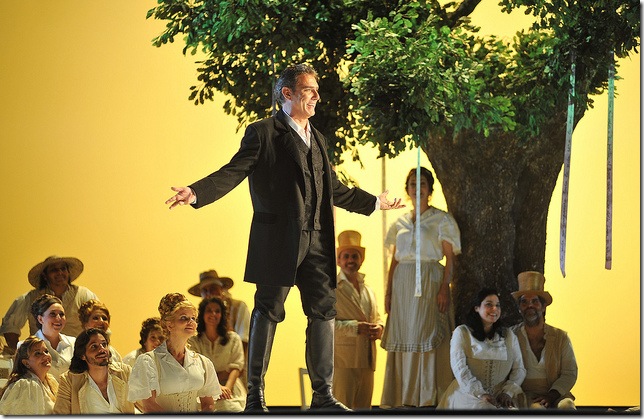Florida Grand Opera’s first-ever zarzuela production, of Federico Moreno Torroba’s Luisa Fernanda, is a handsome thing in many respects.
In a production that originated at Madrid’s Teatro Real, Emilio Sagi effectively uses a simple color scheme of white, black, orange and green, plus old-fashioned theater tricks (think hand shadows on the wall of your bedroom after lights out) as well as the clever use of scrims and a diorama at downstage right, to suggest a Spain in rebellion during the 1868 uprising that overthrew Queen Isabella II.
The chief singers are good as well, with Àngel Òdena’s Vidal particularly compelling, as was Davinia Rodriguez’s Duchess Carolina. And much of the audience was familiar with the operetta: I sat in two different places in the Ziff Ballet Opera House on Sunday afternoon, and each time I landed in the middle of a bunch of sing-along artists.
So it’s a much-loved piece, attractive to look at, and it provided a pleasant afternoon in the theater. Yet it was little more than that, and for a basic reason: Moreno Torroba’s score, which is pretty, sometimes catchy, and often charming, but all in all, painfully weak.
Of course, operetta tends to reflect national taste, and some things don’t translate well to foreign audiences. Arthur Sullivan is not Johann Strauss II, nor are either of them Dmitri Shostakovich, whose operetta Moskva, Cheryomushki is one of the Russian composer’s most extensive pieces. But even with all the untranslatable national peculiarities of their work, they were all creators with strong personalities, and their music makes an impact in spite of the hurdles.
That’s just not the case here. To take one example: In Act III, Luisa sings Callate, corazon, at the moment of her greatest emotional turmoil. The music starts promisingly in the minor, with a dark fragment of melody that suggests something of Falla-esque richness might follow, and none too soon. But no: Moreno Torroba touches on it, and then moves quickly into safer terrain. Here is precisely where a good composer would have broadened the drama and characters with compelling music, but Moreno Torroba simply doesn’t have the goods.
It could be argued that Luisa Fernanda, which premiered in 1932, is just a simple story of love, and deserves appropriately simple music. But this is a political story as well as an amorous story, and it has some presumption to depth that’s not easy to ignore, and that has to be reflected in the music.
This zarzuela, which actually has minimal dialogue, takes place in Madrid, where Luisa Fernanda is in love with the soldier Javier. But she also is being pursued by Vidal, a wealthy landowner. Javier is lured away temporarily by Duchess Carolina, and Vidal decides to join the anti-monarchists as an act of opposition. Javier is captured in battle, but saved by Luisa Fernanda, who nevertheless tells him that she doesn’t love him anymore.
Vidal prepares for his wedding to Luisa Fernanda, but when Javier comes to say farewell to her, she realizes that she still loves him. Vidal understands that Luisa Fernanda will never love him, so he releases Luisa Fernanda from her engagement so she can leave with Javier.
All the principals sang their roles ably. Amparo Navarro’s Luisa was believable and touching, and she has a big top of her register that bloomed attractively. As Javier, the tenor Antonio Gandía sang with a bright, spinto-ish sound that added urgency to his every entrance.
Òdena’s Vidal has some of the best music in the zarzuela, and his big, bronze voice was well-suited to this role. Rodriguez’s Carolina, though sometimes shrill in the highest reaches, nevertheless sang compellingly and brought distinction to a secondary, though not minor, part.
One of the best pieces in the zarzuela is the Act I habanera, Marchaba a ser soldado, which got a fine performance from tenor Daniel Shirley, whose upcoming FGO appearances as Prunier in La Rondine and Tybalt in Romeo et Juliette are now to be eagerly anticipated. Bass-baritone Miguel Sola sang with authority as Don Luis Nogales, but the tenor Martin Nusspaumer, as Saboyano, tended to swallow all his spoken lines, and speak them upstage rather than out to the audience.
The chorus members looked delicious in their all-white, Busby Berkeley-like attire in Act II’s Parasol Mazurka, and in their roles as idealized farmhands in Act III (the beautiful costumes throughout were by Pepa Ojanguren). Their singing was mostly good, but somewhat lacking in commitment, especially in the crowd outbursts, which sounded halfhearted rather than engaged. The orchestra, under Pablo Mielgo, was fine overall, but as with the chorus, there was an occasional looseness about details that made the music sound somewhat sloppy.
Indeed, there was a listlessness in general throughout the production, even amid some of the funnier bits of dialogue and big set pieces like the parasol song. Javier Ulaca’s stage direction seemed untethered to anything; the high dramatic points of Act II, such as the threat of a duel and the proposed mob lyching of the prisoner Javier, went by with almost no punctuation.
And frankly, I think the score again is primarily to blame. A really good piece of music sweeps everyone into it, and drives better performances from one and all, chorus members to lead roles. But a dud, like this one, does the opposite.
It was a good idea for FGO to explore the world of the zarzuela, and perhaps there are other works in the genre that could make more of an impact. At the very least, the company can say it paid due homage to an authentic and cherished Spanish tradition, and that’s to be applauded. But what it really needed was much better music.
Luisa Fernanda will be performed at 8 tonight and Saturday at the Ziff Ballet Opera House in Miami, and at 7:30 p.m. Thursday, Dec. 1, and 8 p.m. Saturday, Dec. 3, at the Broward Center for the Performing Arts in Fort Lauderdale. For tickets, call 800-741-1010 or visit www.fgo.org.


